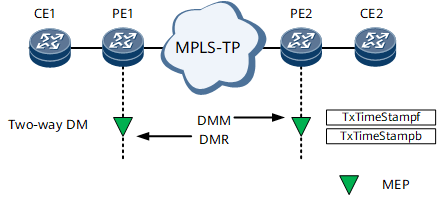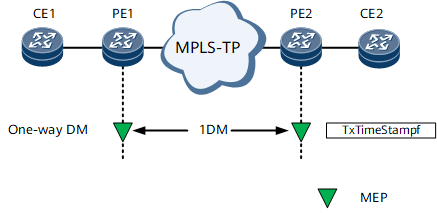Frame Delay Measurement
Frame delay measurement (DM), a performance monitoring function provided by MPLS-TP, calculates the delay time on links. Frame delay measurement is performed in either proactive or on-demand mode. The on-demand mode is used by default. Delay information can be used to calculate the delay variation.
The link delay time can be measured using either one- or two-way frame delay measurement. Table 1 describes these frame delay measurement functions.
Function |
Description |
Usage Scenario |
|---|---|---|
One-way frame delay measurement |
Measures the network delay time on a unidirectional link between MEPs. |
One-way frame delay measurement can be used only on a unidirectional link. A MEP and its RMEP on both ends of the link must have synchronous time. |
Two-way frame delay measurement |
Measures the network delay time on a bidirectional link between MEPs. |
Two-way frame delay measurement can be used on a bidirectional link between a local MEP and its RMEP. The local MEP does not need to synchronize its time with its RMEP. |
One-Way Frame Delay Measurement
Figure 1 illustrates one-way frame delay measurement. A local MEP periodically sends its RMEP one-way delay measurement (1DM) messages carrying TxTimeStampf (the time when a 1DM was sent).
After the RMEP receives a 1DM, it subtracts the TxTimeStampf value from the RxTimef value to calculate the delay time:
Frame delay time = RxTimef - TxTimeStampf
The frame delay value can be used to measure the delay variation that is the absolute difference between two delay time values.
One-way frame delay measurement can only be performed when the two MEPs on both ends of a link have synchronous time. If these MEPs have asynchronous time, they can only measure the delay variation.
Two-Way Frame Delay Measurement
Two-way frame delay measurement is performed by E2E MEPs. A MEP periodically sends a DMM carrying TxTimeStampf (the time when the DMM was sent). After receiving the DMM, the RMEP responds with a delay measurement reply (DMR). This message carries RxTimeStampf (the time when the DMM was received) and TxTimeStampb (the time when the DMR was sent). The value in every field of the DMM is copied exactly to the DMR, with the exception that the source and destination MAC addresses are interchanged.

Upon receipt of the DMR, the local MEP calculates the two-way frame delay time using the following formula:
Frame delay = RxTimeb (the time the DMR was received) - TxTimeStampf
To obtain a more accurate result, RxTimeStampf and TxTimeStampb are used. RxTimeStampf indicates the time a DMM is received, and TxTimeStampb indicates the time a DMR is sent. After the local MEP receives the DMR, it calculates the frame delay time using the following formula:
Frame delay = (RxTimeb - TxTimeStampf) - (TxTimeStampb - RxTimeStampf)
- MEP-to-RMEP delay time = RxTimeStampf - TxTimeStampf
- RMEP-to-MEP delay time = RxTimeb - TxTimeStampb
